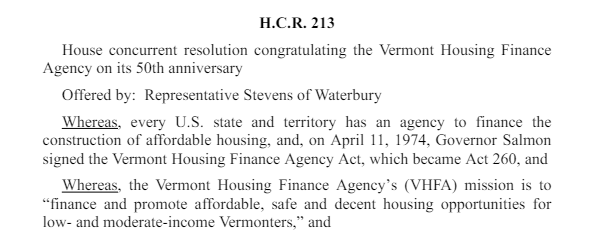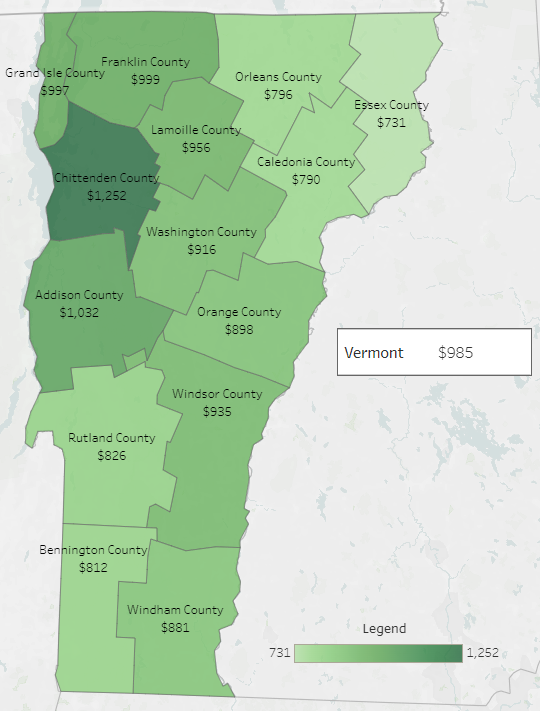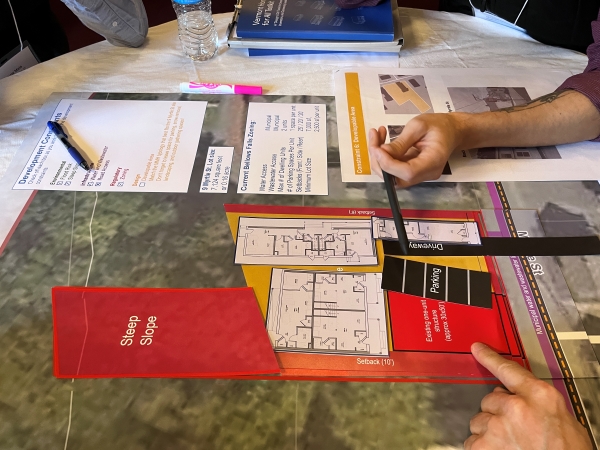
Vermont resolution honoring the contribution of VHFA.
The Vermont Housing Finance Agency (VHFA) turned 50 on April 11, 2024.
They celebrated with a staff party, and a trip to the Statehouse where Vermont lawmakers honored the organization with a resolution recognizing their five decades of devotion to improving access to low- and middle-income housing.
Executive Director Maura Collins says since its inception, VHFA has helped house more than 15% of Vermont. They’ve done that by working with lenders to help fund mortgages for 31,000 Vermont families, mostly first-time homebuyers. They also work with developers to provide financing and federal tax credits that, so far, have built 9,600 affordable apartments. And VHFA is self-funded, getting those dollars by issuing bonds several times a year.
Some of the work VHFA does is in lockstep with the Vermont Department of Housing and Community Development (DHCD). Collins says in her 20 years at VHFA, collaboration with DHCD has been a constant.
“The deepest collaboration has been in the planning department. The agencies both work together to set and reinforce the state’s housing policies. That shows up by promoting smart growth, investing in downtowns, (and) supporting small municipalities when they don’t have capacity to plan or understand housing needs or respond to them,” says Collins.
They do that with Vermont data created and meticulously maintained by VHFA. On HousingData.org you can find a real-time directory of apartments considered affordable, county-based profiles examining demographics, and a section for local decision-makers to consult when assessing their needs to help them chart a path toward solutions.
DHCD housing experts call the website an invaluable tool and say they use it all the time.
Screenshot below from HousingData.org shows median gross rent by county.
 “They are data giants,” says Jacob Hemmerick, DHCD Community Planning and Policy Manager.
“They are data giants,” says Jacob Hemmerick, DHCD Community Planning and Policy Manager.
“Housingdata.org helps frame and narrativize the housing crisis,” says Amy Tomasso, DHCD Community Planning and Project Manager. “Data is such a good tool to explain the particular flavor of the housing crisis in Vermont, because the data goes back a couple decades.”
That data has helped highlight the need to cast a wider housing net. VHFA’s mission has always included low- and middle-income housing, but for the bulk of their first 50 years, they devoted most of their resources to helping low-income Vermonters. Now Collins says the market is not meeting middle income needs like it did a decade ago.
“The biggest market failing has been in housing for low-income Vermonters. Because of those gaps, that’s how we use those resources. In the last several years… that market failure has grown to include many more middle-income Vermonters,” says Collins.
So now VHFA and DHCD are working together on Homes for All to address the Missing Middle.
“VHFA learned Vermont was producing single family homes and large multi-family buildings but no midsized or mid-scale development,” explains Hemmerick. “They’re innovators and thought leaders. They’re always going back to the data to find ways we can move Vermont forward.”
In addition to middle-income homes, Missing Middle also refers to duplexes, four-plexes, small-scale multi-household buildings, and accessory dwelling units which are smaller apartments on the same lot as an existing single-family home.

Homes for All Toolkit being used at the Homes for All Toolkit Trainer Summit in Barre on March 14.
Homes for All is encouraging the creation of Missing Middle homes with a toolkit that includes several different types of designs and case studies to empower local leaders and small-scale developers to create high-quality, affordable units.
Since neighborhood planning and zoning help shape a healthy housing market, VHFA and DHCD are also working together on the Vermont Zoning Atlas which is part of a national push to map out zoning policy in every town in America to provide visual data on housing opportunities and pinch points in local land use. The effort in Vermont involves several local and statewide stakeholders. It’s also getting a boost from students at the University of Vermont and Middlebury College.
There was close collaboration between VHFA and DHCD when COVID hit, too. VHFA stepped up to administer federally-funded stimulus programs to help cash-strapped Vermonters pay their bills – including mortgages, rents, taxes, and utilities.
But the biggest task at hand remains increasing housing options and availability in Vermont. It’s a massive undertaking, but thanks to VHFA, Vermont is moving the needle.

An example of Missing Middle housing.
“VHFA is always innovating and has created a lot of new funding and financing mechanisms,” says Tomasso. “They’re aligning their programs and funding with the needs of Vermont's communities and people.”
“Working together we have changed the conversation around housing in the state of Vermont,” says Hemmerick. “We’ll continue working together to present solutions and solve problems.”
“We are very accessible to each other and work very hard to collaborate and be in alignment on things,” says Collins. “I’m glad to have administration support on some of those initiatives. It’s exciting to work with other partners who really understand the need and the roles for us to play.”
Looking back, Collins says she is proud of what VHFA has accomplished in the last 50 years.
“It’s a really impressive track record that has truly shaped housing in Vermont.”
But she says it’s not Mission Accomplished. There is much more to do.
